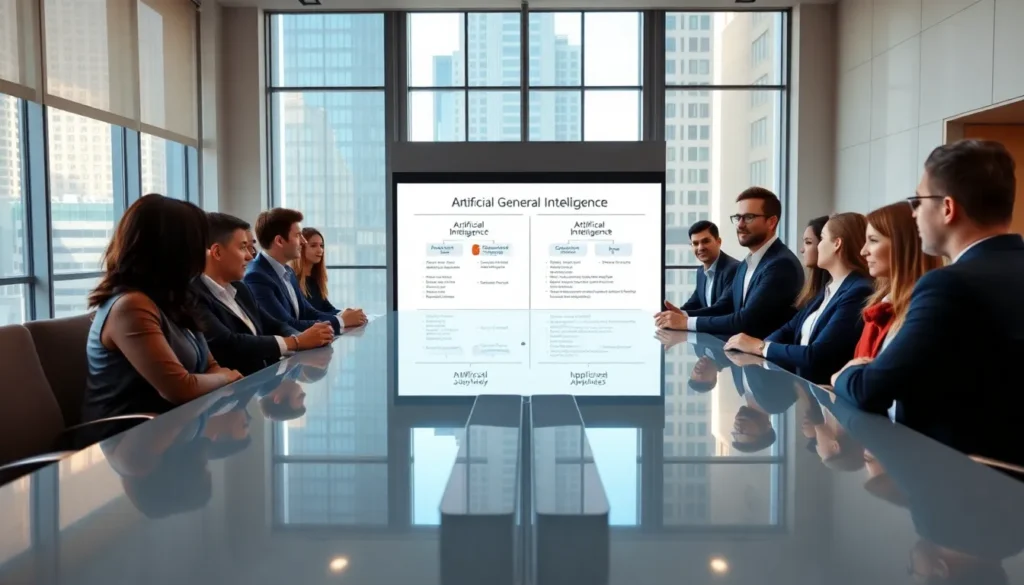Table of Contents
ToggleIn the realm of data analysis, combining artificial intelligence with Power BI is like adding rocket fuel to a bicycle. Power BI already offers a fantastic suite of tools, but sprinkle in some AI magic, and you unleash the full potential of your data. This guide explores how AI enhances Power BI, making your visuals not only pretty but also packed with predictive power. Immerse, and discover how to make your data work smarter, not harder.
Overview of Artificial Intelligence in Power BI

Artificial Intelligence (AI) transforms the way businesses operate, and Power BI is at the forefront of this evolution. With AI capabilities woven into its infrastructure, Power BI evolves from a mere reporting tool into a powerhouse of insights. Its sophisticated algorithms analyze data patterns, predict future outcomes, and help users make informed decisions. The integration of AI isn’t just a value-add: it has become a must-have feature in today’s data-driven world. Imagine predicting sales trends before they even happen or identifying potential market shifts based on historical data, this is the magic of AI in Power BI.
Key Features of Power BI for AI Integration
Power BI comes loaded with features that help seamless AI integration.
1. Natural Language Processing (NLP)
Users can simply ask questions in plain English, and Power BI will translate those queries into data insights. It’s like having a personal data analyst that understands your every whim.
2. Automated Insights
The AI visualizations automatically spot trends and anomalies within your datasets. Forget about pouring over spreadsheets for hours: let Power BI do the heavy lifting.
3. Cognitive Services/API Integration
Users can leverage Azure’s Cognitive Services to infuse their dashboards with additional AI capabilities. This makes it incredibly versatile for various industry needs, from healthcare to retail.
How to Implement AI in Power BI
Implementing AI in Power BI isn’t as daunting as it might seem. Here’s a step-by-step approach:
1. Start with Datasets
Ensure your data is clean and structured. AI thrives on quality input, so throw out the junk data and retain only what’s relevant.
2. Explore AI Insights
Use the Power BI dashboard to access AI insights. Click on visuals to view recommendations and dive deep into automated analysis.
3. Train Your Models
If you’re feeling adventurous, start training custom AI models using your data via Power BI’s integration with Azure Machine Learning. It’s your own research lab, minus the lab coat.
4. Share Your Findings
Finally, share your insights through visually engaging reports. Make your findings shareable and insightful, after all, what good is insight if it stays locked in the vault?
Case Studies Showcasing AI Use in Power BI
Real-world applications of AI in Power BI can be incredibly inspiring. For instance:
Retail Analytics
A national retail chain implemented AI tools in Power BI to analyze customer shopping patterns. As a result, they increased their targeted marketing campaigns by 40%, significantly boosting sales.
Healthcare
A healthcare provider utilized AI for predictive analytics in patient admissions. This strategy enabled them to allocate resources more effectively, drastically reducing patient wait times.
Financial Forecasting
A financial services company deployed AI in Power BI to assess market risks. The accuracy of their forecasting increased, allowing them to navigate turbulent financial waters with confidence.
Best Practices for Using AI in Power BI
To maximize the benefits of AI in Power BI, consider these best practices:
1. Focus on Data Quality
Data quality is paramount. Invest time in cleansing and organizing your datasets. AI can only be as good as the data fed to it.
2. Understand Your Objectives
Clearly define what you want to achieve with AI capabilities. This ensures that your efforts align with business goals.
3. Regularly Update Your Models
AI models should evolve with changing data landscapes. Regular updates ensure that insights stay relevant and actionable.
Challenges and Considerations When Using AI in Power BI
Even though its advantages, integrating AI into Power BI does come with challenges.
Data Security
Data leaks can lead to significant repercussions. Businesses must prioritize robust security measures to protect sensitive information.
Complexity of Implementation
For users unfamiliar with data science, diving into AI can feel overwhelming. Proper training and resources are essential for effective usage.
Future Trends in AI and Power BI
The future of AI in Power BI is promising. Emerging trends to watch include:
Enhanced Predictive Analytics
Expect innovations that improve the forecasting accuracy and depth of predictive analysis, helping businesses to not just react but proactively adapt.
Greater Integration with IoT
The Internet of Things (IoT) will continue to integrate with Power BI, allowing for real-time data analysis from various connected devices.
More User-Friendly Tools
Interfaces will likely become even more intuitive, democratizing data analysis capabilities for non-experts.






